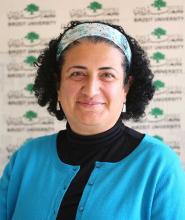To read via PDF: Impact of COVID-19 on the Palestinian Economy
By Dr. Samia Botmeha
The Palestinian economy functions under severe constraints arising mainly from structural distortions caused by the Israeli occupation’s restrictions. Despite the peace process signed over 25 years ago, Palestinians still lack control over vital domains as natural resources, labor and goods mobility, borders, land zoning, and economic tools such as monetary policy. This has resulted in the erosion of the Palestinian economy’s productive base – as evidenced by the changing structure of gross domestic product (GDP) – whereby the shares of agriculture, construction and manufacturing have all declined over the years. In 1994, agriculture accounted to 13% of GDP, and by 2017, its share was only 3.4%. Over the same period, manufacturing declined from 25% to 20%. On the other hand, the contribution of the service sector and public administration rose from 68% in 1994, to 76% in 2017 (PCBS, 2019). These unfavorable structural changes had and continue to have grave repercussions for the Palestinian economy, particularly impeding the capacity of the labor market to generate jobs and absorb workers.
Under these adverse political and economic conditions in Palestine, the first cases of COVID-19 infections were diagnosed in Bethlehem on March 5th 2020. Since then, a series of lockdowns were instated and lifted. As of June 8th, 651 cases have been diagnosed in Palestine; more than 60% of whom were linked to workers in Israel (as per the Prime Minister Office, 2020). This earlier period represents the first wave of the pandemic, as more cases started accumulating and a second wave set in. As such, by mid-August of 2020, more than 22,056 cases were registered in Palestine (including Jerusalem) with 122 deaths (Palestinian Ministry of Health, 2020).
Economic repercussions of the pandemic in Palestine, as in the rest of the world, have been grave. This is particularly true given the rise of the infections in the second wave and the repeated need for lockdowns. In that sense, the pandemic transformed from a health issue into profound economic and labor market shock. This shock has not only impacted supply (production of goods and services) but also demand (consumption and investment), whereby disruptions to production have spread to supply chains. At the same time, all businesses (regardless of size) have been facing serious challenges, especially those in tourism, transport and hospitality industries. As a result, poses a real threat of significant declines in revenue, insolvencies and job losses in specific sectors (ILO, 2020).
The impact on the Palestinian economy manifested itself both on the macro and micro levels. On the macro level, and according to the Palestinian Central Bureau of Statistics, GDP is estimated to decline by 13.5% due to both demand and supply side shocks (PCBS, 2020). Meanwhile, the Palestine Economy Research Institute (2020) estimates a much larger decline in GDP; the losses of which could reach 35% (38% for workers from Israel). As a result, demand in the West Bank economy will shrink by 25% from workers in the Palestinian economy and by 50% from workers in Israel – with an overall total of 30%.
These gross estimates have far reaching repercussions for every aspect of economic life, including employment, workers’ rights, production, trade, standards of living, and others. According to PCBS [the Palestinian Central Bureau of Statistics], 37,336 establishments are estimated to have shut down as a result of the Palestinian Authority’s decision to restrain economic activity starting March 22nd, 2020. These establishments employ 105,345 workers in the WBGS (71,043 in the West Bank and 34,302 in the Gaza Strip), and the total decline in the employment capacity of these establishments is estimated at 26%. Moreover, the Palestine Economic Policy Research Institute-MAS estimates that unemployment is expected to increase in the West Bank to reach at least 36%: During 2019, unemployment rates in the West Bank stood at 15%, which means that the predictions expect a doubling of unemployment. The studies note further that the decline in employment for non-skilled workers will be much higher than skilled workers (15%).
Regarding shutdowns, there are two broad sets of sectors/occupations – of which laborers have continued to work and earn their payroll – that were minimally affected: Those are sectors/occupations working remotely from home (teleworking), as well as those who became known as ‘essential workers’. These two categories include public sector workers[1] such as essential workers in the health, financial and care sectors, in addition to teleworkers in the education sector and non-governmental organizations. In addition, there were Palestinian workers who continued to work in Israel, and a proportion of workers had to conduct essential activities including food production, infrastructure maintenance, etc. Nevertheless, a significant proportion of workers could not continue to work nor receive income during the lockdown periods. Those include informal economy waged workers, casual and temporary workers (including workers in the transport sector), domestic workers, construction workers, and peddlers. Also affected were micro-entrepreneurs and the self-employed (including wholesale and retail trade, transport workers, and restaurants), not to mention regular workers whose sectors (including tourism, hotels, restaurants and manufacturing) were basically shut down.
Among the groups who were hit the hardest are informal economy laborers – employed with no contracts; those are part of the 48% of Palestinian waged workers who do not work based on any form of contract. These workers constitute nearly 50% of workers in the agricultural sector as well as 40% of workers in construction. Many of informal economy workers are self-employed, particularly those working in the transport sector and retail trade (PCBS, 2020). This means that the least skilled workers are the ones who will suffer the most.
Chart: Distribution of laborers working informally in the Palestinian economy by sector, 2019.
Source: PCBS labor force survey (2020).
Poverty rates are expected to increase as a result of the loss of production, shut down of businesses, and loss of employment. This is particularly true given that wages are estimated to decline by 6% as a result of the shutdown of businesses.
On the whole, these estimates show that the impact of COVID-19 on the Palestinian economy is dramatic, with significant effects on GDP growth, demand/consumption, employment, trade, and poverty rates. Policy responses should encompass long-term directives and strategies that take into account the skewed nature and distorted imbalances in the Palestinian labor market. The aim is to strengthen the base of the economy through investment in productive activities that generate employment and avoid job creation that solely focus on temporary transfer of income. This calls for more structural interventions that link micro to macroeconomic policies (focusing on investment and manipulating trade) in order to provide more stable productive employment in the Palestinian economy, as follows:
- Short term interventions can include income support schemes and wage subsidies for workers who lost their jobs/income due to a lockdown (with targeted schemes for nursery workers, taxi and service drivers, domestic workers and other daily workers – both in the formal and informal economies).
- Long term interventions must target the productive sectors – both in manufacturing and agriculture. Strengthening and supporting these two sectors is essential, as they may generate more stable and quality employment opportunities, and lessen dependence on the Israeli economy. In the manufacturing sector, this could be done through prioritizing certain sub-sectors/domains within the sector for support. The selection of these subsectors, in addition to economic requirements, should take into account the restrictions imposed on Palestinians as a result of Israel’s occupation. Also, these sectors’ supply chain networks – especially the local ones – must be strengthened so as to better utilize local inputs and expertise, and lessen imports from the Israeli economy in particular. All things considered, it is necessary to also provide better training of human resources working in these sectors via offering quality vocational training, particularly on issues related to the use of technology, innovation, marketing, and inputs.
References:
[1] These workers were paid their entire salaries for the months of March and April, but half of their salary for the months of May and June.
- Palestinian Prime Minister’s Office (August, 2020). Accessed on August 7, 2020, at:
- Palestinian Central Bureau of Statistics (various issues) Labor Force Survey. Ramallah: Palestine.
- Palestinian Central Bureau of Statistics (2020) Economic Impact of COVID-19: Facts and realities. Ramallah: Palestine.
- Palestinian Central Bureau of Statistics (March, 2020) Economic forecasts for 2020 in light of the current outbreak of the Coronavirus. Press release. Ramallah: Palestine.
- Palestinian Ministry of Health (July, 2020), accessed on July 15 at: https://www.facebook.com/mohps/posts/2971319839660541
- معهد ماس (2020) تقييم أولي للآثار المحتملة على الاقتصاد الفلسطيني لتفشي وباء كوفيد 19 في الضفة الغربية. المراقب الاقتصادي – عدد خاص. رام الله: فلسطين.
- معهد ابحاث السياسات الاقتصادية الفلسطيني – ماس (2019) المراقب الاقتصادي رقم 57. رام الله: فلسطين.
Samia Botmeha is an Assistant professor in economics at Birzeit University. She was the director for the Centre for Development Studies at Birzeit University till 2014. She has also worked with the Palestine Economic Policy Research Institute (MAS) in Ramallah as a researcher. She has completed her PhD at the School of African and Oriental Studies- University of London, in labour economics. Areas of interest and publications are gender economics, labour economics, and political economy of development. She has engaged in research on alternatives to neo-liberal development in the West Bank and Gaza Strip, the economics of the one state and gender differentials in labour market outcomes.
Rosa Paper is a collection of analyses and relevant viewpoints irregularly published by the Rosa Luxemburg Stiftung Regional Office of Palestine and Jordan. The content of Rosa Papers is the sole responsibility of the author and does not necessarily reflect the position of the Rosa Luxemburg Stiftung Regional Office of Palestine and Jordan.
The Rosa Luxemburg Stiftung is one of the major institutions of political education in the Federal Republic of Germany. It serves as a forum for debate and critical thinking about political alternatives, as well as a research center for progressive social development. It is closely affiliated to the German Left Party (DIELINKE).
The Rosa Luxemburg Stiftung has supported partners in Palestine since 2000, and established the Regional Office in Ramallah in 2008. Today, the office is in charge of project cooperation with partners in the West Bank, in East Jerusalem, and in the Gaza Strip as well as in Jordan.









